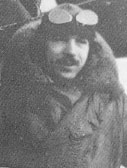Henry Biziou facts for kids
Quick facts for kids
Henry Biziou
|
|
|---|---|

Henry Arthur Richard Biziou
|
|
| Nickname(s) | "Weegee" |
| Born | 18 September 1894 Farnborough, Hampshire, England |
| Died | 14 July 1919 (aged 24) Farnborough, Hampshire, England |
| Buried |
Aldershot Military Cemetery, Hampshire, England
|
| Allegiance | United Kingdom |
| Service/ |
Royal Navy British Army< Royal Air Force |
| Years of service | 1914–1919 |
| Rank | Captain |
| Unit | No. 42 Squadron RFC No. 87 Squadron RAF |
| Battles/wars | First World War |
| Awards | Distinguished Flying Cross |
Captain Henry Arthur Richard Biziou (born September 18, 1894 – died July 14, 1919) was a brave British pilot during the First World War. He was known as a "flying ace" because he shot down eight enemy planes. He started his military career in the Royal Navy, then joined the British Army, and finally became a pilot in the Royal Air Force. Sadly, he died in a plane crash after the war ended.
Contents
Early Life of Henry Biziou
Henry Biziou was born on September 18, 1894, in Farnborough, Hampshire, England. As he grew up and joined the military, his friends and fellow pilots gave him the nickname "Weegee."
Serving in the First World War
Henry Biziou joined the Royal Navy on October 29, 1914, at the start of the First World War. He began as a mechanic, helping to keep military vehicles running. Later, he became an officer and moved to the infantry, which means he served as a soldier on the ground.
From Ground to Air
Biziou fought with the 6th Battalion of the Green Howards regiment in important battles. These included the Gallipoli campaign, and fighting in Egypt and France. While still with the army, he was chosen to join the Royal Flying Corps on October 6, 1916. This was the air force of the British Army at the time. He started as an aerial observer, flying in planes to spot enemy positions and movements.
Becoming a Fighter Pilot
After gaining experience as an observer, Biziou trained to become a pilot. He learned to fly at a special school in Gosport. In April 1918, he joined No. 87 Squadron RAF in France. He flew a Sopwith Dolphin, which was a type of fighter plane.
On May 6, 1918, Henry Biziou achieved his first aerial victory. This was also the very first victory for his squadron! Over the next few months, he became a highly skilled pilot. By September 22, he had shot down two enemy reconnaissance planes (used for spying) and five enemy fighter planes. He also forced another enemy fighter to crash. Because of his excellent flying and leadership, he was promoted to temporary captain on July 2, 1918.
Distinguished Flying Cross
For his bravery and success in the air, Henry Biziou was awarded the Distinguished Flying Cross (DFC). This is a very important award given to officers in the Royal Air Force for acts of courage during flight.
His award was officially announced on December 3, 1918. The announcement praised him as "a most successful leader of marked gallantry." It mentioned that he had destroyed four enemy planes and forced another down. It also highlighted a day on September 15 when he shot down two enemy planes in one fight against many Fokker biplanes. He even forced down an enemy balloon!
Life After the War and Death
After the First World War ended, Henry Biziou continued to serve in the Royal Air Force. He was stationed at RAF Farnborough, which was an air base.
Sadly, on July 14, 1919, he was killed in a flying accident at Farnborough. His S.E.5 plane collided in mid-air with another aircraft, an Avro 504. Henry Biziou and the two people in the other plane died in the crash. He is buried in Aldershot Military Cemetery in England.
Images for kids


